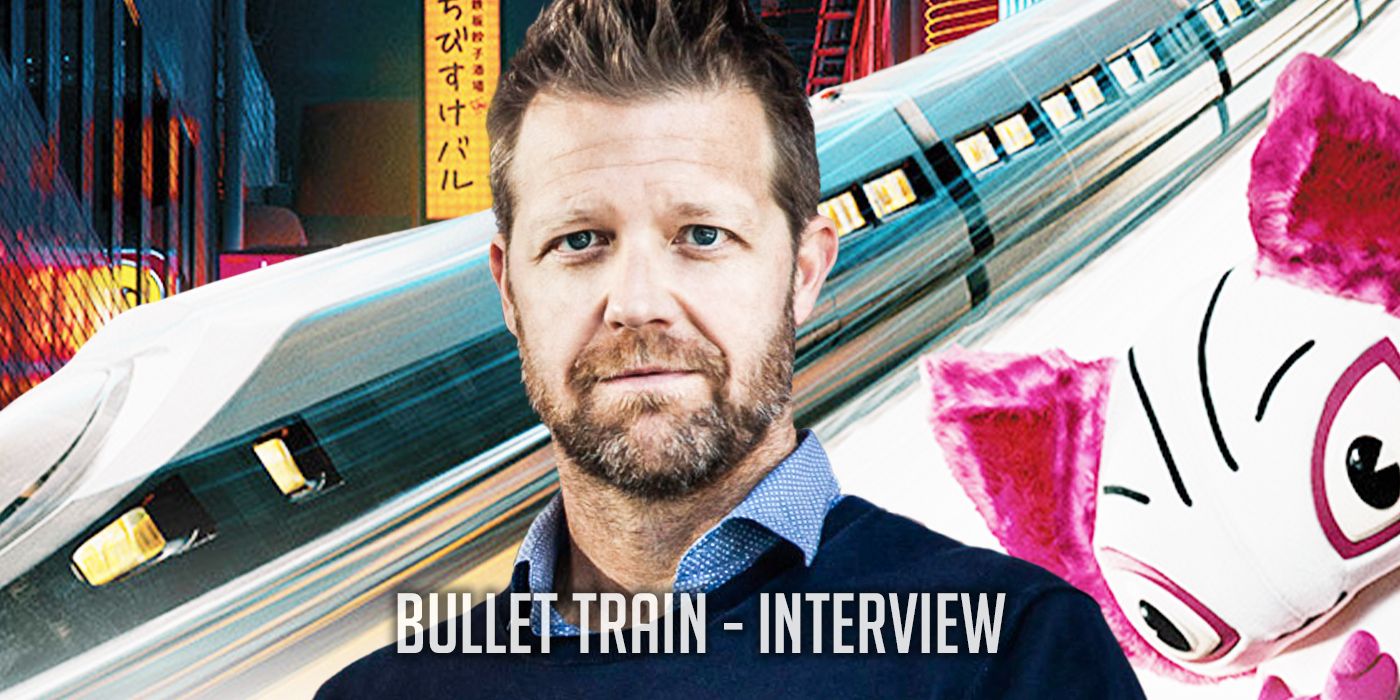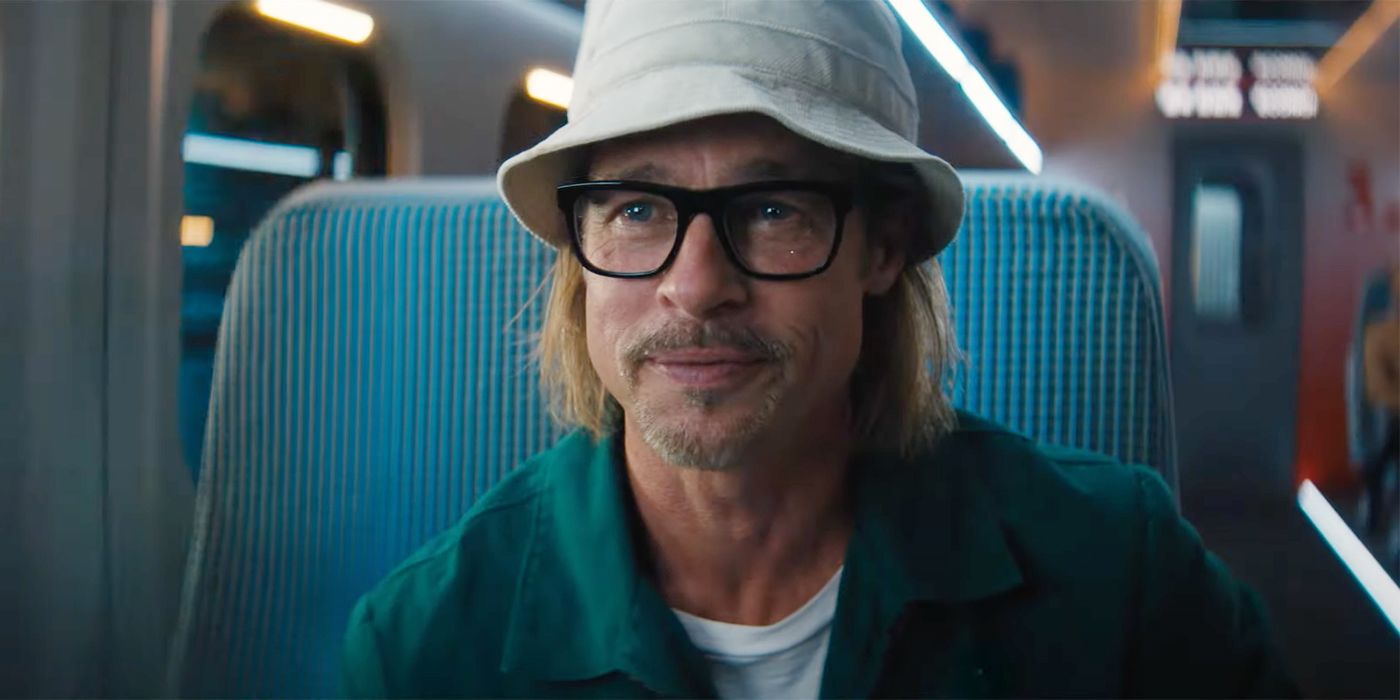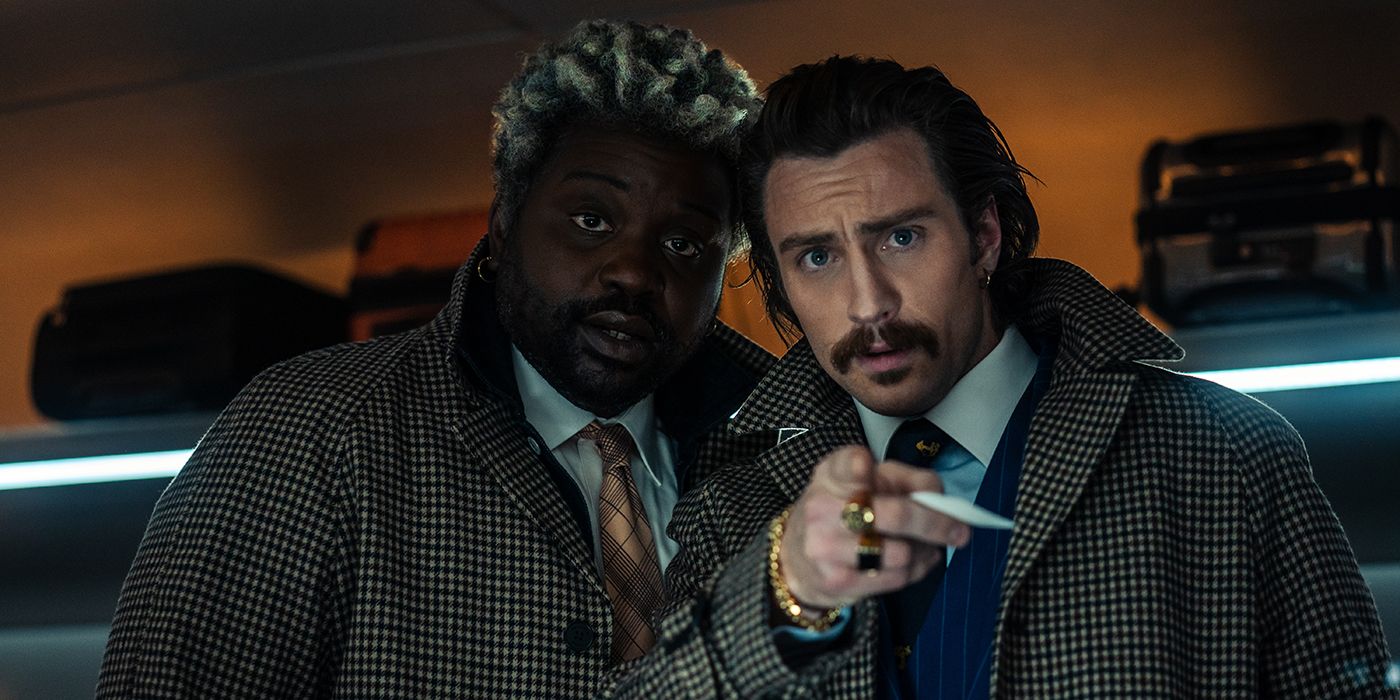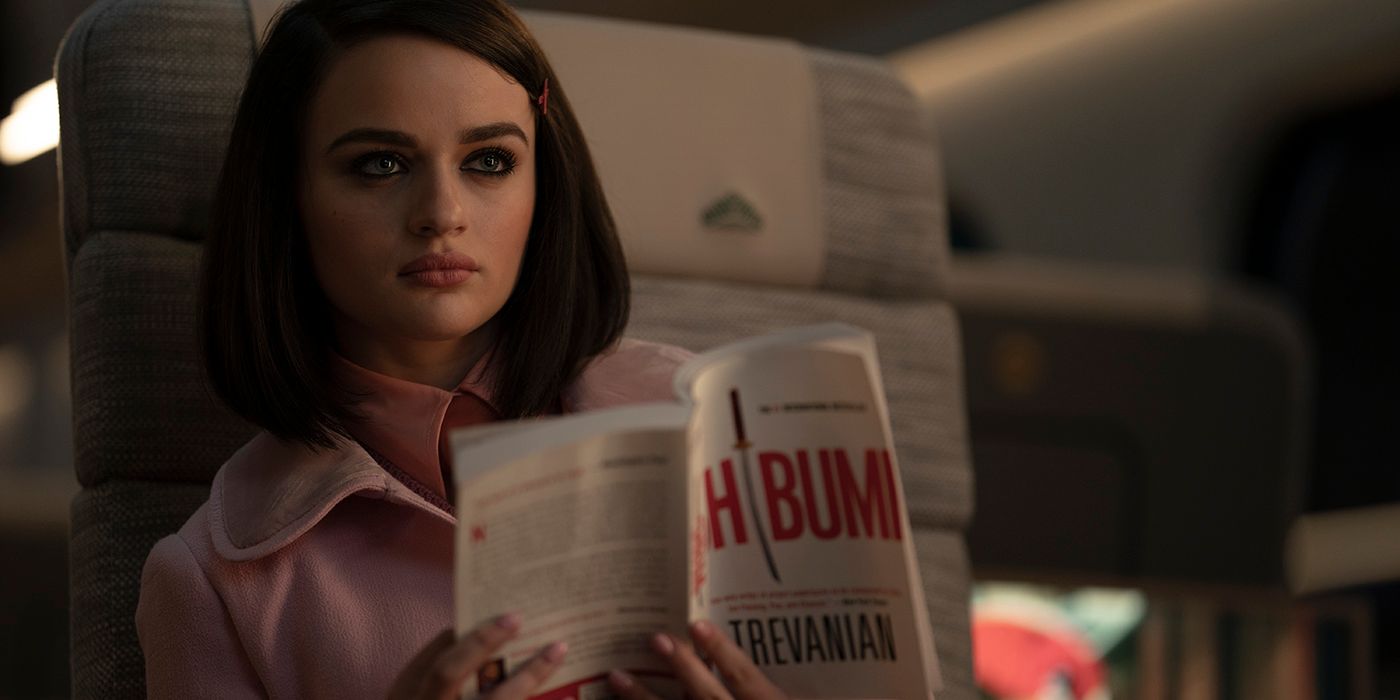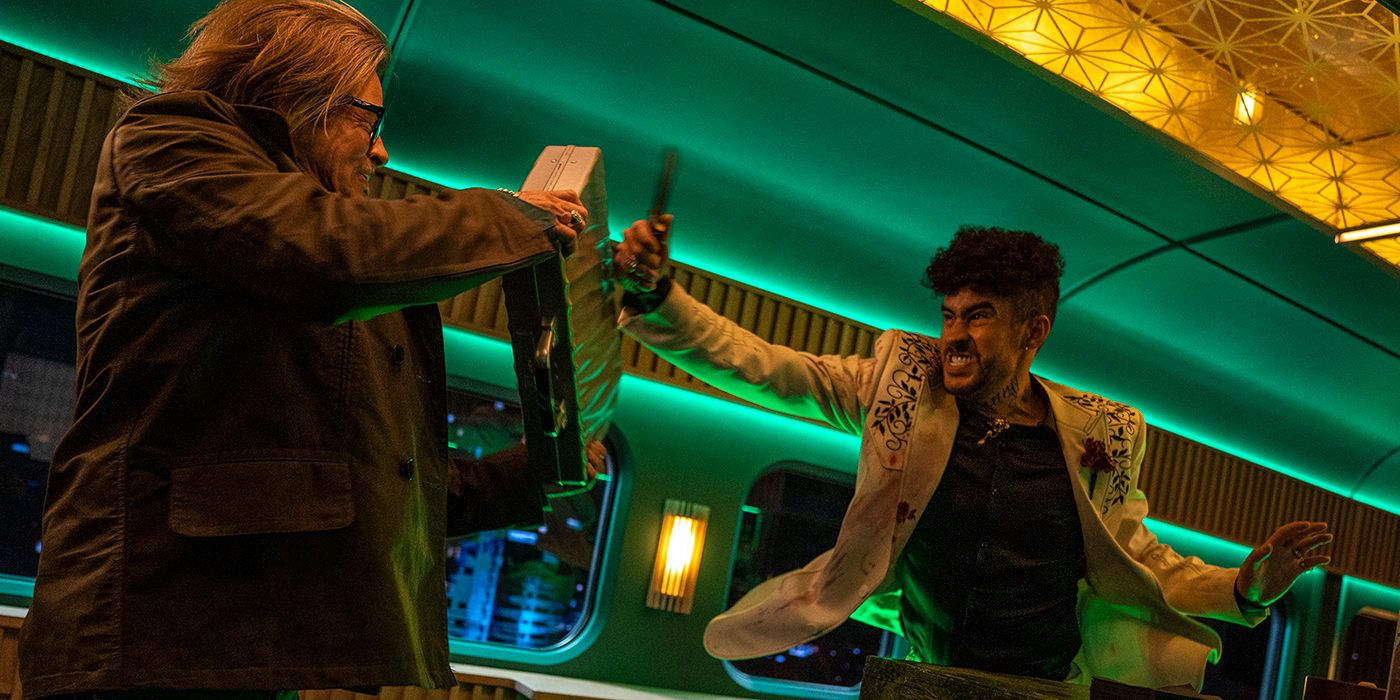With Bullet Train opening in theaters later this week, I recently got to speak with director David Leitch about making his fantastic new movie. If you haven’t seen the trailers, Bullet Train was adapted from the Japanese mystery-fiction book Bullet Train written by Kōtarō Isaka, the Japanese best-selling and award-winning novelist. Just like the novel, the movie takes place in Japan on the titular bullet train on a trip from Tokyo to Morioka. On the train there are a number of assassins whose assignments are very much interconnected, though they don’t know this until things start to go haywire when the assassins start trying to kill each other.
Loaded with inventive action set pieces, a script that will keep you guessing, and fantastic performances from the entire cast, Bullet Train is absolutely worth seeing in a movie theater. The film stars Brad Pitt, Aaron Taylor-Johnson, Brian Tyree Henry, Joey King, Andrew Koji, Hiroyuki Sanada, Zazie Beetz, Michael Shannon, Logan Lerman, Hiroyuki Sanada, Masi Oka, Sandra Bullock, and Benito A Martínez Ocasio aka Bad Bunny.
During the fun interview, Leitch talked about what it was like finding out Pitt wanted to do the movie and what it’s like behind-the-scenes when trying to cast him, how they filmed most of the movie on a soundstage on the Sony backlot (you won’t believe it after you see the film), filming the action sequences, and what he learned from test screenings. He also provided updates on the Nobody sequel with Bob Odenkirk and his next movie, an adaptation of the Lee Majors TV series, The Fall Guy, with Ryan Gosling.
Watch what he had to say in the player above, or you can read our conversation below.
COLLIDER: I want to start with, I know how hard it is to get Brad Pitt to sign on to a movie. He gets offered every script in the industry with those, for people that don't realize, the script comes with, "We're ready to pay you, please make the movie." So how did you convince him to do this? Was it the fact that you've known him for so long?
DAVID LEITCH: I was as shocked as you are right now. Yes, I've known him for a long, long time, but to get Brad Pitt on a movie is like lightning in a bottle. And so, when Kelly brought me Bullet Train and I read it, and we were like, "Oh, okay. I'm in, I'm in. Kelly, I'm in. Okay, we'll figure out the characters. Okay, Ladybug, it's Brad. It's got to be Brad." And talking to Sanford Panitch, they had done a bunch of movies with Brad together, and he's like, "We can do it. We can get him. We can get him." And I'm like, "Can we?" And it was a lot of anxiety sending it over. I just was like, "Is he going to want to do it? It's so crazy and wacky and irreverent, and I don't know." And I'm like, "I just don't want to waste his time." And Sanford's like, "I'm doing it, I'm doing it."
So Sanford sent it. I wasn't even necessarily ready. And then boom, they got it. Brad threw the script to the wolf, and that's how he tells the story. He's like, he was in. He was laughing his ass off, he saw Ladybug, he's like, "I can play this guy. Oh, and it's David. I want to do something with him. And I have a window. This feels great." And so, he called me and said, "Leitch, I think we're doing this thing. You want to do it? Let's do it." It was really kind of a surreal moment. As good of a friend as he is, it's still surreal, like, "Oh, now... I've been working with Brad for so long, supporting him as a stunt double, building characters, now he's going to build this character that supports me as a filmmaker." It's pretty awesome.
Also, once he signs on, the picture is an immediate go.
LEITCH: Yeah.
I'm sure everyone at the studio, everyone is like, "Oh, this needs to happen. What are we doing?"
LEITCH: Correct. That is one of those things where it's like, "Oh, now we're not kind of looking for a production window." It's like, "When can Brad make it?" Brad wants. Brad's like, "We're going to make it now." "Great, we're making it now." Forces mobilize. And so, it is one of those watershed moments in a filmmaking process, where you get your lead talent and everything's activated, and it's double that when it's Brad.
Well, one of the things that I just can't believe, and I don't think anyone will believe after they watch the movie, is 90-something percent of this movie was shot on a Sony backlot in Culver City.
LEITCH: Yeah. Not even a backlot per se. Inside a stage.
Sure.
LEITCH: Oh, we were hoping at some point that, during pre-production, COVID would lighten up, and we could get to Japan. So, there was part of me that was like, "Oh." I was really bummed when we realized we're never going to get in. This is like a pipe dream. And again, now you're talking about the train is already rolling, so to speak, no pun intended, but there's a window. Brad's doing it during this time. So it's like, "Okay, what's the version of this movie where we try some of this new virtual production technology? Mandalorian-style stuff. So met with visual effects, met with cinematographer, Jonathan Sela, and we started to research this idea of, "Let's have LED screens outside of the train. Can we shoot plate material in Japan with a remote crew before pre-production?" which we did, "Augment the plates, stitch them together, create some digital plates, heightened stuff, and get this all done in the next eight weeks before we step foot on a train?" And the answer was, "No fucking way."
As movies happen, it's just like, "Of course, there's a way." Film crews are the most resourceful and creative people on the planet, from my experience. Everyone just mobilized. Mike Brazelton, [an] incredible VFX supervisor who worked at DNEG for years, and came onto this project as his first supervising role. He took the reins and made that stuff happen outside the walls. That was piece one of the puzzle. The other was platforms. We're telling stories on these different platforms and journeys. So David Scheunemann, the production designer, came up with this ingenious idea to reclad, make it a modular platform. Some of the structures were structural, some of the poles were structural, some of them were facades, right? And we could remove them and take them and reclad them, reclad walls, put in set walls, to make this one platform feel like a journey of seven platforms. It could be redressed within a day or two, because of our schedule. And again, just the ingenuity of it all, it still blows me away what our department, construction, and visual effects pull off. For what we do, it's just, I've been in the business almost 30 years, and it still blows me away.
The virtual stuff you did on this movie, it's really incredible. How much from what you did on this are you planning on taking with you to future projects? Because it does seem like you can go anywhere in the world if you do this right.
LEITCH: Well, I think I'll always be more of an organic filmmaker. I'll lean into... I need to be inspired by a location, I need to be inspired by the touching and feeling and seeing things. And it's just, there are great filmmakers that can design out of their vision in their head, and then they can create that vision in digital worlds. And that's just not necessarily me. This is my first glimpse into that, and I think, every time I go out as a filmmaker, I've learned skills. I honed my comedic chops with Deadpool, and worked on sort of a comedy balance and dramatic narrative on Hobbs and Shaw. And now I've taken away more of a technical idea of this sort of visual effects virtual production, and I'll use it. I'll use it, but at the heart of me is still the stuntman choreographer who goes to a location, is inspired by that fall potential, or goes to this location, is inspired by the arches here, and I want to shoot them. And so, I think I'll always be that.
You know I like talking about the editing process. How did the film change in the editing room as a result of friends and family screenings or test screens?
LEITCH: A lot and not a lot. I think we have... Look, it's my long-time collaborator, Elisabet Ronaldsdottir, you know her, John Wick, Atomic Blonde, Deadpool, and now Bullet Train, she's amazing with characters. I think we were servicing seven characters on this movie. Obviously, in the photography, we had gathered the arcs, really beefy arcs in all the sort of the beats we wanted to hit for every character, but then that movie is three hours long. So then you're like, "How do we distill this movie, keep the pace, keep the momentum, but still have these satisfying journeys for these characters?" And she's the master of that.
She has done such a beautiful job with it. But I will say, the thing I learned from Deadpool, and comedy can really be empirical. You can test screen things and you can learn. And so, I'm not... I love the testing process. You can test and hear people laugh, you know the joke works. You can test and hear people don't laugh, you know the joke doesn't work. So yeah, the movie changes in post, but again, I think almost every scene in the movie is there from the original script, but it's distilled into the essence of what it needed to be for this. So yeah, it's changed, but not tremendously from the project. I mean, you make the movie three times. That's the cliché, right? We had this vision for it in the script. Then, on set, there's all these beautiful, beautiful magical moments that happen. Momomon is created out of thin air during shooting, and it becomes an integral plot point. Then you get into post, and you start to play with the storytelling aspect and the narrative, and then it's made again, and it's made in its best form. And I got to have a great collaborator for that.
I think a lot of people don't realize that you might have, in your assembly cut, a five-minute scene, and that five-minute scene becomes two minutes in the movie.
LEITCH: Yeah, but it also has the essence... So it has, at that point, exactly what you need. And again, Taika had made this comment recently, for whatever it's worth, I saw a headline where he's like, "I'm not into director's cuts, because they're director's cuts because they're bad," or whatever like that. There's some truth to that. There's a reason you go through this process of distilling, distilling, distilling the story and making the journey as satisfying as possible for the audience, so.
Completely. I think there's a difference between, like Kingdom of Heaven: The Director's Cut, which is three hours, and it's a masterpiece, and the studio mandated two hours and 15, 20-minute version.
LEITCH: Yeah. I mean, that's not a hard-and-fast rule in any way.
You know how much I enjoyed Nobody. I know you guys are developing a sequel. What exactly is happening with a sequel to that film?
LEITCH: Oh, I think everyone's really excited about it. Everyone involved is like, "Full steam ahead." We are in the script process, and I think we had so much fun making that. Kelly and I had a blast, the actors had a blast, the studio loved the results, and it's happening. I mean, I think it's happening as fast as we can make it happen.
Well sometimes people talk about sequels, and they never actually happen. Do you think it's actually going to happen?
LEITCH: Yes, I do. I do, because there are these certain journeys that you go on, and they're just undeniable experiences for the people involved. And that was one of them. And I think all of us want to go back and play in that universe, and we want to see Bob bring that character to life again.
I know you're getting ready to do... you're going from Brad Pitt to Ryan Gosling. It's a tough journey for you.
LEITCH: Oh yeah. Hard, hard.
What can you tell people about Fall Guy, which I believe you're filming later this year?
LEITCH: I can tell you a little. I mean, it's sort of a... It's a reimagining of the show from the '80s, the late '70s, early '80s, "Lee Majors starring." It's about a stuntman who gets embroiled in some crazy drama outside of the movie business, and mayhem ensues. So, there's fun and action, and we're trying to make a big summer movie with it. Universal's incredibly supportive and Ryan's been really collaborative on the material, and we're starting shooting in October. We're in pre-production right now.
I think one of the reasons why you can have a lot of fun with Fall Guy because it takes place in the movie world. So you can have a lot of cameos that feel organic to the world. Is that something you're thinking about?
LEITCH: Well, I don't... I mean, I think what we want to do... We'll definitely want to have fun with the movie world. I think, again, for all of us involved, it's sort of like, "Yes, it's about a stuntman." So whatever drama that's happening to this guy, it's like any other movie. It's a great world for that drama to be happening in. And then it's so rich with anecdotes from Kelly's experiences, my experiences, Ryan's experiences. We're definitely going to have a lot of fun playing with the movie, our movie experiences inside of this movie.
I completely get it. And my last question on Bullet Train. This movie is loaded with action. And as everyone knows, or should know, action is not easy to film. It requires a lot of rehearsal, preparation, and it's a lot of work. On which sequence, or what day, did the cast basically come to you and say, "Fuck off. This is too much." I'm joking around, but you know what I mean.
LEITCH: We plan every action scene and we choreograph it, and we do what we call stuntvis, where we shoot and edit it. I'm sure you've seen it, and you've probably posted versions of it on your site where, "The scene that was done with the stunt guys, and now here's the scene in the movie." And so, we did all that for this movie, but there's still these times where you're inspired by something. And one of the fights with Aaron Taylor-Johnson and Brad Pitt, it changed cars. It turned out I wanted, I thought it was more fun to be inside of the service car where the concessions were, where the concession cart could come in, and we could do this sort of fun gag with the concession girl. Problem is, that set wasn't made to fly. The walls couldn't move.
So logistically, you got a camera operator in there, you got a China ball light, and you got sound, and you're trying to move and fight. And that was hard. It was hard. The other places we'd really had prepped to create space, moved chairs. "Now we're at this angle, we have all this breathing room over here, but it's going to feel confined." That was really confined. And the actors stepped up and delivered, and it was tough. I mean, you're bumping your elbow on a real piece of furniture, or you're trying not to swing as far as you can because the camera's right there where it normally would be back a little bit. And so, they did a great job, and I kind of threw them in the shit on that one, but they were professional. They did it.
For more on Bullet Train
- 'Bullet Train' Promo Encourages You to Watch it in IMAX, Unlike Aaron Taylor-Johnson [Exclusive]
- 'Bullet Train' Character Posters Shows Off Star-Studded Assassins
- Joey King Teases 'Bullet Train' and Her First-Day Jitters Working with Brad Pitt and David Leitch
- 'Bullet Train': Brad Pitt Narrates a Viral Ad Teasing an Upcoming Trailer for David Leitch's Assassin Film

